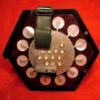
Ardie
Members-
Posts
146 -
Joined
-
Last visited
Profile Information
-
Gender
Male
Recent Profile Visitors
1,259 profile views
Ardie's Achievements

Chatty concertinist (4/6)
-
The most common definitions are tremolo=variation of amplitude and vibrato=variation of pitch. With free reed instruments the later is difficult to achieve in some regular way. You can do it one way by "bending the note" as with blues harmonica playing. What are you actually doing David? I also believe that very frequent and energetic tremolo practise with concertinas might wear the bellows out a bit quicker but everything is relative. Done gently it ought to do no more harm than any pumping. Have you heard of reeds being damaged by it? That might be more serious...
-
Geoff Crabb recently mentioned in another topic that B/F# was the most common Crabb Anglo around 1890-95. Since this seemed very surprising to me I have presented the hypothesis that they actually were meant to be used as Bb/F instruments IF being in Old Philharmonic pitch which was quite common with concertinas up to late 1920s. Old Philharmonic pitch is a=452,5 which means that such a B/F# instrument is 50 cent high compared to a Bb/F one in a=440 ( or rather 439 = "New Philharmonic pitch"). The reason for my guess is that who would really use a B/F# Anglo as such and for what purpose? I don't know any popular instrument having either B or F# as natural keys and these keys are not choosen for much written music either.
-
The description sounds exactly like the much-discussed bowing valves of H. Boyd. I don't know anything about the role of H.Boyd concerning the "bowing valves". The inventor of them however was James Alsepti according to his patent application No 8290 dated 8th July 1885. The function is described in the patent and the musical use firstly in the tutor "The modern English concertina Method by Signor Alsepti" published by Lachenal & Co. They have often been ridiculed for being a theoretical improvement or marketing gimmick only but no doubt they may be used for some sophisticated articulation executed by the bellows rather than just by hitting buttons for sounding a note. In everyday practise it is probably hard to find musical phrases complex enough to motivate someone to aquire the skill to use them though... If someone insists playing violin concerto solos with the concertina maybe...
-
This seems to support my assumption in the earlier post."The concertina in question" thus was right in the middle between B/F# and Bb/F ! That makes it exactly corresponding to an original Bb/F instrument in Old Philharmonic Pitch (a=452,5). Furthermore - IF being a "B/F#" instrument - such a low pitch ( below a=430) has not been commonly in use since 18th century which also makes is less plausible that B/F# anglos in low pitch were common in the 1890s. My conclusion remains being that the instrument (like others of the kind) is/was meant to be a Bb/F in high pitch.
-
... this may just mean that it has been retuned, or that it really is in B/F# and still in Old Philharmonic pitch, which, as has been pointed out, is already halfway to C/G in modern pitch.... Makes it even more mysterious as I see it.Retuning often causes confusion. My thought was that an anglo marketed,sold or intended for playing in B/F# would be strange anyhow. Who does preferrably use these keys at all?? So - if reeds are stamped B/F# etc the initial "true" tuning and musical intention likely has been Bb/F ( but in Old Philharmonic Pitch) or C/G If it presently is closer to C/G this may be the result of later repitching or that the maker for whatever reason just used a set of reeds with a non conventional stamping. It may have been sold/intended to be either a Bb/F or C/G instrument then but I would doubt B/F# . Geoff - have you come to some other conclusions? Are there possibly some Crabb firm documents shedding light on the matter?
-
This seems a bit odd does it not? Neither B, nor F# are expected to be frequently used keys in the folk music segment and not in the Salvation Army music either. The later has been mainly related to common keys for brass instruments and a great part of SA Anglos consequently have been tuned in Ab/Eb for that reason BUT also in Old Philharmonic Pitch meaning a=452,5 since this was used in brass ensambles for a long period after New Philharmonic Pitch was established A Bb-instrument tuned to a=452,5 is 50 cent high compared to one in a=440 which would make it equal to a B-instrument in a=440 50 cent low.These "B/F#" instruments thus may have been Bb/F instruments in Old Philharmonic Pitch. But were they actually specified and sold as "B/F#" ? Can this possibly just have been a practical routine differing them from Bb/F instruments in some more modern pitch?
-
Traditional /Electronic Concertina Combination
Ardie replied to Alan Day's topic in Instrument Construction & Repair
To disappoint you a little Alan I can't find these hybride ideas very fruitful.The concertinas as we know them are children of their time and truly mechanical devices.The lot of various electrified traditionally mechanical instruments may have a transitional place of course but to make them a progress in longer terms they must do something better. The bellows is basically just a pump and not needing it for pumping air through mechanical free reed as a sound source makes using the bellows slightly absurd, for example.To add the dynamics of tone control, mechanically offered by the bellows in the trad concertina, into an electronic "concertina" better be done without any bellows.If you don't want to establish this function separately ( as with an organlike piano keyboard) the musically most efficient variant would be integrating the function in the button - i.e you would at the best have both: 1) the piano concept = the harder you hit the button the greater the amplitude 2) the organ concept = when pressing the button the amplitude may be increased. Combining some speed and pressure sensors into the button function is a challenge, not impossible, but probably quite expensive. It would result in an entirely new keyboard instrument with musical options similar to string instruments. But in the electronic environment maybe you better just use sampled concertina sound and arrange the dynamics in your computer...not much for a pub session maybe...but pubs vanish also... -
I'm not at all convinced about that. I don't know about Anglos but pinning my hand at one side to a thumb rest would restrict my hand too much. It also stops you playing notes with your thumb, a surprisingly useful technique. Resting it on your knee or a hanging it from a harness seem the only options available if you want to really use a duet properly. I've met a couple of EC players with thumb problems too. What is hanging a 71 key duet from your thumbs going to do for you? Ceemonster; you can play stuff quite fast on a Maccan, the problem is if you stick to one note melodies you'll have a hand spare most of the time; bit of a waste really! You have to hold a concertina between your hands - more or less.Of course IF you rest it on your knee or hang it up this reduces the holding effort but two main principles remain the same: 1) you need stability to find the notes and to control the amplitude. 2) you need flexibility to reach the distant keys (unless as I said the keyboard is so limited that you reach all with a fix hand position). Now - you've got two traditional solutions holding the concertinas: - by a handstrap ( a la Anglo/Duet/Bandonion ) - by a thumbstrap a la English. They work differently but handling the different concertinas is basically the same kind of work so how could either one of these variants possibly be ideal?? or generally better than the other?? Is it not possible that some synthesis might offer improvements both of stability and flexibility? First comes stability. Without that you will get poor music since you won't find the note and can't control its amplitude.So - which part is preferrably used for stabilization? The thumb? (a la English). The midpart of the hand? (a la Anglo/Duet). The wrist? Concerning speed...(= playing single note sequences as fast as possible). It ought to be selfevident that the English is generally superior simply because you may employ double as many fingers for the same job.
-
You certainly can do without the finger rest - better employing the little finger for button work - but skipping the thumb strap is hardly a very good idea. The reason that the "hand strap a la anglo" works with the anglo is that you can have a fix hand position with 3(-4) rows only.With larger duets and Englishes with 48 or more keys it is a poor solution however since you have to slide to reach the distant keys and the hand strap gets too unstable. Stabilizing the connection by the thumb is the right way to go and adding a thumb strap on Anglos and Duets would be logical.
-
Treble vs. tenor treble...Of course any larger (larger cross section) instrument will be slower than a smaller one even if they have a comparable standard (tightness, reed quality)otherwise. You may not notice it very much if you don't test at the extremes of course.If you play a fast sequence of notes only on push OR on pull the factor muscular force/pressure gradient (responsible for sound amplitude)which is greater for a larger instrument may not be as evident for the speed as if you play the same note sequence by changing push/pull for every note when the necessarily greater muscular effort will present itself more obviously.The smaller the instrument the faster you can do this. Compare playing in the same octave with a treble and a baritone, or a miniature and a baritone-treble.
-
It is completely impossible to have any good idea what the cause of your trouble may be or a rational view on suitable treatment without a close examination. Do see a doctor and/or a professional ergonomist. The question *how* deep the thumb "should" be put into the strap is an everlasting debate issue. It is firstly a personal question related to other individual playing habits but putting it as far in as possible stabilizes the thumb and thus is expected to result in reduced load on thumb joints and less strain for thumb muscles.A wider ( ca 30mm) thumb strap which immobilizes the distal joint is expected to improve this situation even more. If you have just started to play the piano then you are using muscles that you are not used to using in this way and they will be sore. They need to get fit and more of the same but in a gentle way (not too much playing) will strengthen them. Geoff. Basically true concerning fitness by sensible practise which firstly means that coordination and efficiency improves. The greater "strength" one may experience after the initial phase is mainly greater endurance. There is much misunderstanding around concerning importance of "strength" (=muscular power) however.You don't need strong hands/arms in that sense for playing neither the piano nor the concertina and "strengthening exercises" mostly is just waste of time for a person who is generally fit.
-
English Keyboard layout dimensions
Ardie replied to PaulDC's topic in Instrument Construction & Repair
The spacing itself doesn't need to influence the transition very much.You switch pretty easily from one computer or telephone keyboard to another - don't you? Same between a normal piano and a piano accordion. There are two spacings to consider. The button centre to centre distance and the button side to side distance.The first is important related to the finger width, the second to the button travel.Since you make your device "from scratch" you can choose not only these measures freely you also can pick whatever keyboard system you want and that of course is a very complex individual matter that may be discussed for ever. The standard english keyboard spacing is too narrow both longitudinally and transversely for most people.Compare with the full size computer keyboards. If your MIDI "concertina" will be fairly stationary you may to some part use a "flying hand" ( as when playing the piano) and a slightly larger keyboard size will be no disadvantage. Press buttons with a diameter 10-13 mm are mostly preferrable and are commonly used for calculators, computers, telephones etc. -
English Keyboard layout dimensions
Ardie replied to PaulDC's topic in Instrument Construction & Repair
Are you building a MIDI "concertina" from scratch?? - i.e. just using the keyboard and not using the device carried between your hands and a bellows in between at all? Are you very anxious using the standard keyboard and button dimensions? and why in that case? These measures were obviously choosen initially with the intention making a 48 key instrument with the necessary 96 free reeds for sound sources as compact as possible in a portable unit much based on the earlier "Symphonium" idea. IF you are making a MIDI instrument today - independent from these mechanically determined characters why not modify the measures to make them more functional and comfortable? -
I haven't come across your problem but it sounds as if your straps are much different from the traditional ones - like those you find on Wheatstones or Lachenals. Do you know these so you can describe the difference or can you possibly send a photo? I get the impression that the rigid ( metal) part of the thumbstrap is too wide/high for you and maybe there is too much width between this rigid part and the loop or clasp that holds the soft strap down also. In that case they probably are wrongly designed for many people. In my view traditional thumbstraps are not very functional either but of course individual thumb size determines what is suitable or not. My thumbstraps are wider ( 30mm compared to 20-25mm) , thicker, more padded, and steadier than common ones.To work fine the thumb straps should fixate the thumb comfortably and immobilize the distal joint so that you don't need to use any muscular force by the thumb (or the little finger) to hold the instrument. This makes the contact with the instrument more stable, improves tonal control and you reach all you want anyway. A functional thumbstrap is essential for playing English so don't try some provisory "quick fix" - get some good ones instead somewhere.
-
Annoying button click, finally gone
Ardie replied to Jody Kruskal's topic in Instrument Construction & Repair
It sounds as if the problem is not vibrations but either the leather grummet (or similar) between lever and pad or the lever end itself hitting the metal end when tapping the button hard.Have you tried filing off a little on the grummet or lever end or replacing the grummet with a smaller one? A more lasting measure in such case.

.thumb.jpeg.09943e9e2f2a23918324c6151aa2597b.jpeg)





